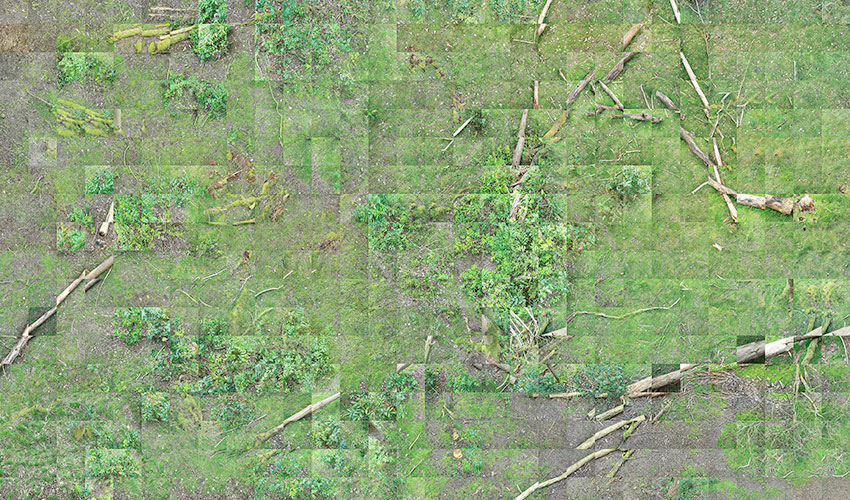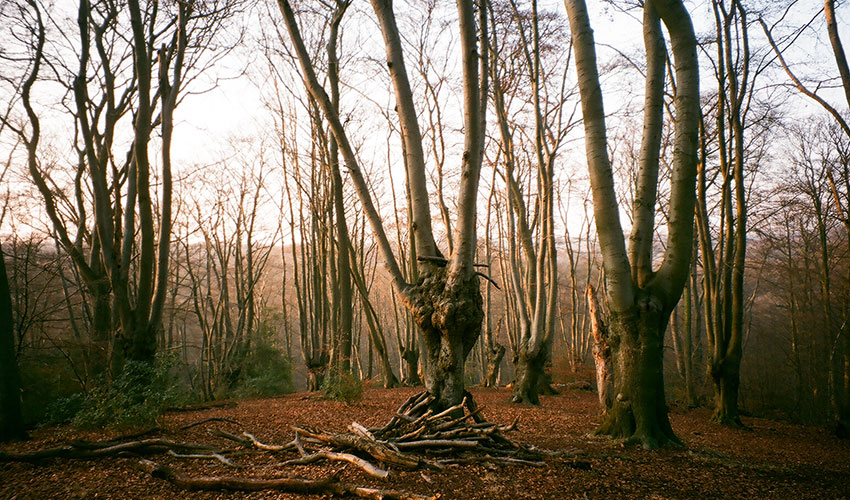Text by Meritxell Rosell

Western thinking and practice over the last centuries have brought a tangible separation of human beings from the rest of the natural world. Many scientists, artists and intellectuals have reflected on this disconnection from the natural: from Thoreau in the early 19th century to Lovelock and Margulis – who formulated the Gaia theory in the 70s- and more recent currents of thought like Geopoetics.
In the last five years, there’s been a profound increase in the concern for our environment. Reconnecting with the media we live in and understanding and preserving its ecosystems and cycles has become an ubiquitous part of our social and cultural life; as a result, the number of artistic projects that involve nature and propose other ways of understanding our relationship with it as human beings are increasing at the same rate as we, as a species, become more and more aware of our responsibility.
And in this sense, Living Symphonies, a sound installation (and music composition) in Epping Forest in London (until July 29, 2019), fulfils these sentiments to express a sensitive and intelligent contact with the world both physically and emotionally.
Living Symphonies has been created by the artistic duo Jones/Bulley and local musicians, who worked to represent each species of Epping Forest through a unique set of melodic and rhythmic motifs that portray their changing behaviour over the day and night. Living symphonies is part of The People’s Forest season, a year-long programme of events curated by Kirsteen McNish and Luke Turner to celebrate Waltham Forest borough’s unique relationship to Epping Forest.
The season will explore multiple themes inspired by the forest, including nature writing, sexuality, gender and the history of the woods. Writer and editor Luke Turner himself published at the beginning of this year the acclaimed Out of the woods, a fierce and brave autobiographical memoir about sexuality, shame and the lure of the trees, with Epping Forest as a story catalyst.
For this installation, the area was mapped out and given a full ecological survey, so the artists would know precisely what flora and fauna are in the area. All the identified elements have associated a unique musical motif – recorded by musicians from the local area: Ellie Wilson, Chloe Herington, Sarah Anderson, Jenny May Logan and Sam Glazer – which changes and moves according to the weather conditions and time of day. A butterfly, for example, will act differently considering the time of the day and weather conditions. Accordingly, the music changes and develops following the environment. These ever-changing and complex symphonies are reproduced via a network of speakers, merging with the sounds of the forest.
Jones/Bully shared some further thoughts on the piece, their creative process and Living Symphonies’s most transcendental meaning.

When you commissioned this project, was the intellectual process behind the inception of the piece?
Both of us have always been fascinated by the intricacy of forest ecosystems and the ways in which the flora and fauna are so fundamentally enmeshed. Our previous works translate the dynamics of weather systems (Variable 4, 2010-), radio broadcasting (Radio Reconstructions, 2012-) and internet conversations (Vespers, 2015) into autonomous long-form musical compositions. The forest is really one of the archetypal examples of a self-organising system, and so made a natural evolution of our work.
The opportunity to bring this piece to Epping Forest was particularly interesting for us. Because it has a long lineage of deer keeping and livestock grazing, with careful management by the Forest Keepers, it is very much a product of humans and nature working together. This means it has some very distinct ecological characteristics: a thinned-out canopy means more sunlight reaches the forest floor. Dead wood is left to decay, giving rise to a diverse and thriving ecology on the ground. Woodland pasture ecosystems such as Epping are becoming vanishingly scarce nowadays, so it felt like a rare privilege to bring the piece here.
What is for you the experience of working alongside scientists (ecologists and wildlife experts) like?
Working with ecologists and wildlife experts is intrinsic to how Living Symphonies works. Without the knowledge of people who spend their lives within the specific area of forest that the piece is sited within, we would only have an abstract and generalised view of what happens within the ecosystem.
In the runup to the installation, we do a detailed metre-by-metre survey of the flora present within the site, and spend a period of time speaking with local experts to learn about what animal inhabitants are likely to pass through it over a day. And this information is not just the preserve of scientists, but of local people with a passion for the forest — in this case, Epping Forest Conservation Volunteers, to whom we owe a debt of gratitude.
What were the biggest challenges you faced for the development of the installation?
The elements always pose the biggest challenges in Living Symphonies — staging a technologically complex work in the forest wilderness. To give the sense of sound materialising from the undergrowth, we need to conceal about 2km of speaker cable, which takes several days’ work. We’re off-grid, so to power the installation sustainably, we’ve selected a low-carbon hybrid generation system, which means getting a two-tonne lithium battery into the woods. Everything has to be rain-proof, which requires a specialised speaker system. And to be resilient to overheating from the sun, one of our technicians has built a large-scale air-flow system to continuously cool all of the kit.
Working on this project, what have you learned about the biorhythms of the forest? Anything that you can apply or incorporate into your musical practice?
All of our works are about extending what’s possible within our musical practice, incorporating the flows of complex systems to create a dynamic and generative composition method. The unusual characteristic of the forest ecology is that it has ecosystems nested within ecosystems, which means that — just like a piece of music — there are multiple layers of structure, with changing equilibrium of repetition and variation over time.
At the top level, there’s the day-long circadian rhythms of animal activities, along with day/night cycles and weather conditions, which give the piece a long-term cyclical structure. Within this, individual species have shorter-term “ultradian” rhythms, in which they might be active and restful for a period. Finally, giving the piece its continual unpredictability is the moment-to-moment interactions of animal activities and predator-prey dynamics, with each inhabitant reacting to those around it.
For us as artists, it’s about finding the balance between compositional coherence and the infinite variance of the natural world. The reward is that, even as the makers of the work, we’re still continually surprised by the arrangements that it generates.






